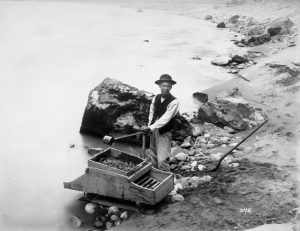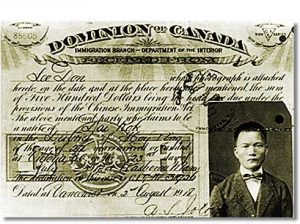5.12 The Chinese in Canada
Timothy J. Stanley, Faculty of Education, University of Ottawa
People from China have been in what is today called Canada since before the country existed. Indeed, 50 carpenters and shipwrights from Canton became the first permanent resettlers on Canada’s West Coast when the English sea captain John Meares abandoned them at Nootka Sound in 1789. Ironically, their efforts at building a fur trading fort and ship consolidated the British claim to the Pacific Coast.

Those of Chinese origin have been continuously present in British Columbia since the 1858 Fraser River gold rush, arriving at a time when the territory was a First Nations one and the non-First Nations population was a few hundred. By the 1880s, Chinese (mainly made up of people from Guangdong province in south China) were likely the second largest group in BC after First Nations. However, after Confederation in 1871, the first legislature of the Province of British Columbia ensured that people of European origins would dominate the new Dominion by taking the right to vote away from Chinese and First Nations peoples. At the time, the racialized White minority was less than 20% of the population.
By World War I, at virtually every turn, legislated discrimination surrounded people of Chinese origins living in British Columbia. In addition to being barred from voting, they could not work for provincially incorporated companies, for the government itself, underground in coal mines, or on crown licenses. Indeed, by 1914 the province had enacted 112 pieces of discriminatory legislation against them and other Asians. In the face of this discrimination, many Chinese moved to other provinces, where discrimination was common but not as systemic. They often worked with other Chinese immigrants in labour-intensive settings that required little initial capital. By the 1940s, virtually every town of any size in Canada had a Chinese restaurant or hand laundry.

In 1885, John A. Macdonald extended disenfranchisement to the federal level and introduced a discriminatory immigration Head Tax on Chinese workers and their families. By 1904, the Head Tax reached $500, more than an average worker’s yearly wage. In 1923, the federal government banned Chinese immigration to Canada outright. Between 1923-1947, when the legislation was repealed, Chinese immigration to Canada effectively ended. The future Governor General Adrienne Clarkson and her family were among the handful of exceptions allowed. This discriminatory legislation prevented Chinese families from being reunited in Canada. In 1941, 95% of the married Chinese men in Canada were still separated from their families. Supposed bachelors in Canada endured years of loneliness while their wives and kin in China were caught in poverty, civil war, and the Japanese invasions of the 1930s and World War II. It was not until the 1980s that the family structure of Chinese-Canadian communities came to resemble that of other Canadian communities. In the 1980s-1990s, China became the most important source country for immigrants to Canada, moving away from the community’s historic roots in Guangdong province in south China, to northern China. Today, the Chinese community in Canada includes a majority of people who are immigrants and who speak Mandarin as their ancestral language and who come from professional and entrepreneurial backgrounds in China. At the same time, there are others who are seventh or even eighth generation Canadian whose ancestral languages are various dialects of Cantonese, Taishanese, and Hakka, but whose primary languages are English or French. As such, there are many different Chinese communities in Canada.
Throughout their history in Canada, people of Chinese origins and their Canadian-born children, have fought for full political and democratic rights, and for full participation in Canadian life. They have helped to make Canada the democratic and inclusive society that it is today. They organized associations and governing institutions to protect their interests and for mutual support. They formed political organizations designed to make China strong so that it could protect their rights. They fought for inclusion in people’s idea of Canada, moving it from one that was originally envisioned as a White, European nation to one that includes all of its peoples equally.
Key Points
- The Chinese presence in British Columbia predates the Fraser River and Cariboo gold rush, but the numbers grew rapidly during that time and increased again in the 1880s.
- Chinese immigration was managed through the imposition of a Head Tax in 1885 and restrictive legislation in 1923.
- The diversity of emigrants from China has produced a complex pattern of distinct immigrant communities in Canada.
Attributions
Figure 5.23
Chinese man washing gold (Online MIKAN no.3192437) by Library and Archives Canada / PA-125990 is in the public domain.
Figure 5.24
Head Tax Recipt by Shizhao is in the public domain.

